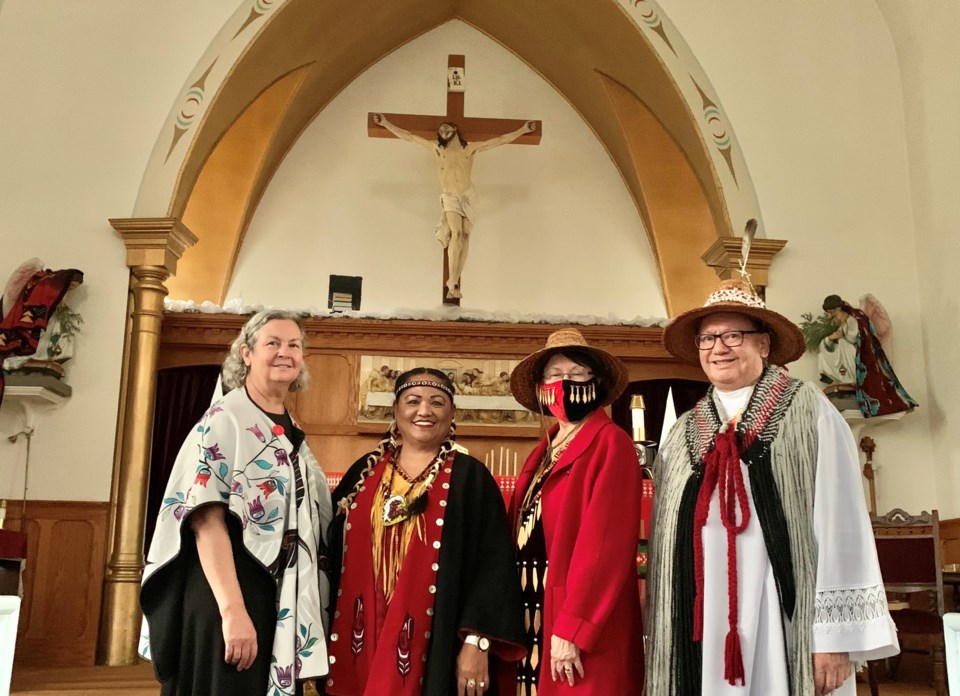St. Paul’s Indian Church is on a path of integration, merging Sk瘫wx瘫wu虂7mesh Sni虂chim (麻豆社国产language) and traditional knowledge with Roman Catholic teachings and faith.
Lead by 麻豆社国产Elder and Catholic Deacon Rennie Nahanee, the church is holding Sunday masses in 麻豆社国产language, in effort to decolonize the space and bring back those to the church who may be disenfranchised with the religious institution.
The ), on the north shore of the Burrard Inlet, was erected in 1868. It is the oldest Catholic mission church in the Lower Mainland and a designated national historical site.
Nahanee is confident the church can be a vessel for cultural revitalization, and ongoing education about 麻豆社国产language and teachings.
“I believe that learning our language, our culture, our customs, and our dance can all be done here, as a way of preserving and saving all those things. Because this is a forever institute, the church.”
Nahanee first began integrating 麻豆社国产language in his services at a funeral at the Chief Joe Mathias Centre, presenting the Lord’s Prayer in Sk瘫wx瘫wu虂7mesh Sni虂chim.
He recalled feeling the immediate connection with people in attendance; however, he is aware that some might not understand what he is “trying to do” by integrating 麻豆社国产language into his services.
“Some of them are still angry with the residential schools. They're carrying on a fight that began with our parents or grandparents, so some of that anger is passed down.”
But Nahanee wants people to remember that it is their ancestors who were the ones who were part of the original church community.
“I'm not sure that they realize that, but they used to work in here,” he said. “When I was in elementary school, that's what I saw: Elders from our community working in the church, about 10 of them doing different jobs. Uncle Louie was always welcoming people … with a great big smile, nice big warm hands.”
Nahanee is cognizant, however, that the trauma and violence the residential school system inflicted on Indigenous communities has many now questioning the role the Catholic Church can play in healing.
“I see things on Facebook … somebody asking, ‘Why would a Native person be working in a church that destroyed their culture?’ And I say, because I learned from my Elders here, our community, and I respect them, and [I want to] carry on the work that they started.”
Nahanee has looked both internationally, in places like India, and more locally around Greater Vancouver, where Catholic churches have integrated traditional languages and cultures.
“People that are having [mass] celebrated in their own culture and language, I think it becomes more alive that way,” he said.
Inside St. Paul’s, traditional Catholic adornments are slowly being swapped out to include a heavier 麻豆社国产presence within its walls. The fleur-de-lis that originally covered the architraves have now been replaced by repeating Coast Salish eyes, and the angels that hang above the altar are now adorned in blankets.
Traditional 麻豆社国产songs and dances are also being included, with Nahanee explaining how The Journey Song welcomes parishioners at the mass while also recognizing those who “are no longer with us.”
“We are greeting people that are here, and we are, in a sense, thanking those that came before us for giving us our culture back.”
These moments of integration are also a way for Nahanee to bring his 麻豆社国产Catholic mentors back into the space and into the services he’s creating.
“I can still see them. I can still see their faces. And I'm sure they would be smiling now.”
One piece of decolonizing the church, Nahanee said, is by changing the stories that are usually told within mass.
Acknowledging that Catholic teachings often speak of lambs and pigs, and other animals that are not native to 麻豆社国产territory, he said traditional stories that are grounded in geographical place make more sense.
“The great example is the good wolf and the bad wolf.
“A grandfather's telling his grandson about two wolves that are fighting inside themselves forever. The grandson asked, ‘Grandfather which one wins? The good wolf or the bad wolf?’ And the grandfather says, ‘Whichever one you feed,’” he said. “That speaks a whole lot about good and evil in that little story there. And it's something that we can relate to, because we know about wolves, we have songs about wolves, we have dances about wolves.”
Bringing 麻豆社国产language into the masses has also been a personal journey for Nahanee, as he himself is learning the language, while trying to bring it into the church.
Working with Aaron Williams, and other 麻豆社国产language teachers, Nahanee and his wife go to Joe Mathias Centre every Wednesday to learn drums songs and language.
“I want to do more than just throw one word in, here and there. That’s a challenge to me, because I never really spoke the language before, but I always wanted to learn,” he said, adding while laughing, “Now that I brought it to the church, I'm under pressure to learn it.”
The next Sk瘫wx瘫wu虂7mesh Sni虂chim mass will be held Nov. 28 at St. Paul’s Indian Church at 11 a.m.
Charlie Carey is the North Shore News' Indigenous and civic affairs reporter. This reporting beat is made possible by the Local Journalism Initiative


